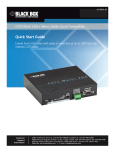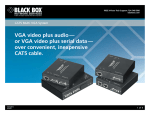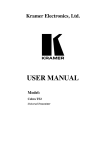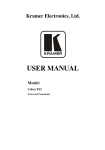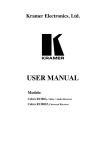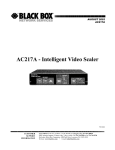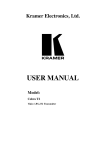Download CAT5 Multi VGA System (VGA and Audio)
Transcript
MAY 2006 AC1001A-SR CAT5 Multi VGA System (VGA and Audio) © Copyright 2006. Black Box Corporation. All rights reserved. 1000 Park Drive • Lawrence, PA 15055‐1018 • 724‐746‐5500 • Fax 724‐746‐0746 CUSTOMER SUPPORT INFORMATION Order toll-free in the U.S.: Call 877-877-BBOX (outside U.S. call 724-746-5500) FREE technical support 24 hours a day, 7 days a week: Call 724-746-5500 or fax 724-746-0746 Mailing address: Black Box Corporation, 1000 Park Drive, Lawrence, PA 15055-1018 Web site: www.blackbox.com • E-mail: [email protected] FCC/IC RFI STATEMENTS, EU DECLARATION OF CONFORMITY CAT5 MULTI VGA SYSTEM Contents FEDERAL COMMUNICATIONS COMMISSION AND INDUSTRY CANADA RADIO FREQUENCY INTERFERENCE STATEMENTS This equipment generates, uses, and can radiate radio-frequency energy, and if not installed and used properly, that is, in strict accordance with the manufacturer’s instructions, may cause interference to radio communication. It has been tested and found to comply with the limits for a Class A computing device in accordance with the specifications in Subpart B of Part 15 of FCC rules, which are designed to provide reasonable protection against such interference when the equipment is operated in a commercial environment. Operation of this equipment in a residential area is likely to cause interference, in which case the user at his own expense will be required to take whatever measures may be necessary to correct the interference. Changes or modifications not expressly approved by the party responsible for compliance could void the user’s authority to operate the equipment. This digital apparatus does not exceed the Class A limits for radio noise emission from digital apparatus set out in the Radio Interference Regulation of Industry Canada. . Chapter Page 1. Specifications....................................................................................................3 2. Introduction ......................................................................................................4 2.1 Overview.....................................................................................................4 2.2 Package Contents .................................................................................….4 2.3 Equipment You May Also Need...................................................….......….4 2.4 Compatible Cabling ...............................................................................….4 3. Setup and Installation..........................................…......................................….5 3.1 Cabling Considerations.............................…...................................…...….5 3.2 Making the Connections.................................…............................….....….5 3.2.1 Connections and Setup in General .........…....................................…5 3.2.2 Connections on the Single-Port VGA/Audio (AC1000AR2–AC1001A)............................................................….....6 3.2.3 Connections on the Quad Hub VGA/Audio Transmitter (AC1003A)..........................................................................…...........7 3.2.4 A Typical Single-Port Transmitter–Receiver Application ..….....…....8 3.2.5 A Typical Quad Hub Transmitter–Receiver Application................….9 Le présent appareil numérique n’émet pas de bruits radioélectriques dépassant les limites applicables aux appareils numériques de la classe A prescrites dans le Règlement sur le brouillage radioélectrique publié par Industrie Canada. EUROPEAN UNION DECLARATION OF CONFORMITY The manufacturer declares that this product meets the requirements of EU Directive 89/336/EEC. NORMAS OFICIALES MEXICANAS (NOM) ELECTRICAL SAFETY STATEMENT INSTRUCCIONES DE SEGURIDAD 1. Todas las instrucciones de seguridad y operación deberán ser leídas antes de que el aparato eléctrico sea operado. 2. Las instrucciones de seguridad y operación deberán ser guardadas para referencia futura. 3. Todas las advertencias en el aparato eléctrico y en sus instrucciones de operación deben ser respetadas. 4. Todas las instrucciones de operación y uso deben ser seguidas. 5. El aparato eléctrico no deberá ser usado cerca del agua—por ejemplo, cerca de la tina de baño, lavabo, sótano mojado o cerca de una alberca, etc.. 6. El aparato eléctrico debe ser usado únicamente con carritos o pedestales que sean recomendados por el fabricante. 7. El aparato eléctrico debe ser montado a la pared o al techo sólo como sea recomendado por el fabricante. 8. Servicio—El usuario no debe intentar dar servicio al equipo eléctrico más allá a lo descrito en las instrucciones de operación. Todo otro servicio deberá ser referido a personal de servicio calificado. 9. El aparato eléctrico debe ser situado de tal manera que su posición no interfiera su uso. La colocación del aparato eléctrico sobre una cama, sofá, alfombra o superficie similar puede bloquea la ventilación, no se debe colocar en libreros o gabinetes que impidan el flujo de aire por los orificios de ventilación. 10. El equipo eléctrico deber ser situado fuera del alcance de fuentes de calor como radiadores, registros de calor, estufas u otros aparatos (incluyendo amplificadores) que producen calor. 11. El aparato eléctrico deberá ser connectado a una fuente de poder sólo del tipo descrito en el instructivo de operación, o como se indique en el aparato. 12. Precaución debe ser tomada de tal manera que la tierra fisica y la polarización del equipo no sea eliminada. 13. Los cables de la fuente de poder deben ser guiados de tal manera que no sean pisados ni pellizcados por objetos colocados sobre o contra ellos, poniendo particular atención a los contactos y receptáculos donde salen del aparato. 14. El equipo eléctrico debe ser limpiado únicamente de acuerdo a las recomendaciones del fabricante. 15. En caso de existir, una antena externa deberá ser localizada lejos de las lineas de energia. 16. El cable de corriente deberá ser desconectado del cuando el equipo no sea usado por un largo periodo de tiempo. 17. Cuidado debe ser tomado de tal manera que objectos liquidos no sean derramados sobre la cubierta u orificios de ventilación. 18. Servicio por personal calificado deberá ser provisto cuando: A: El cable de poder o el contacto ha sido dañado; u B: Objectos han caído o líquido ha sido derramado dentro del aparato; o C: El aparato ha sido expuesto a la lluvia; o D: El aparato parece no operar normalmente o muestra un cambio en su desempeño; o E: El aparato ha sido tirado o su cubierta ha sido dañada. 1 4. Troubleshooting................................................................................................10 4.1 Common Problems ...................................................................................10 4.2 Calling Black Box ......................................................................................10 4.3 Shipping and Packaging ...........................................................................10 Appendix A. Cabling Pinouts................................................................................11 TRADEMARKS USED IN THIS MANUAL Any trademarks mentioned in this manual are acknowledged to be the property of the trademark owners. 2 CHAPTER 1: Specifications CAT5 MULTI VGA SYSTEM 1.Specifications 2. Introduction Cable Required: Between transmitter and receiver(s): Category 5 shielded or unshielded twisted pair (STP or UTP), though STP is virtually never necessary Compliance: 2.1 Overview CE; FCC Class A, IC Class/classe A Video Support: to UXGA (1600x1200 @ 70Hz), RGBHV, RGB, Composite, SVideo, Component Video modes Resolution and Refresh Rate: At 250 ft. (76 m) or less, 1600 x 1200 at 70 Hz Transmission: . The CAT5 Multi VGA System extends VGA video signals over ordinary Category 5 cable. All models support RGBHV, RGB, and VGA video, and they use a transmitter-to-receiver setup. They can be used as video splitters as well as video extenders. This manual covers the AC1001A-SR CAT5 Multi VGA System Receiver. The video/audio models enable you to broadcast line-level mono audio, along with video from your computer, to as many as 100 computer monitors up to 450 feet (137.2 m) away over CAT5. Transparent to users (automatic, no delay) Among the transmitters available for both video/audio and video/serial models are single-port models and four-port (quad hub) versions. The quad hub transmitter is used to distribute the same signal to multiple display devices. Setup and cabling are the same as the single-port transmitters. Required Source Impedance: Video OUT: 75 ohms; Audio OUT (if any): 600 ohms maximum Required Destination Impedance: Video IN: 75 ohms; Audio IN (if any): 600 ohms minimum WARNING This equipment is not intended for, nor does it support, distribution through an Ethernet network. Do not connect these devices to any sort of networking or telecommunications equipment! Audio Characteristics: Channels: Right/Left summed; Line Level 600 Ohm Unbalanced 2.2 Package Contents You should have received the following when ordering a CAT5 Multi VGA System receiver: • The receiver. • External power supply (100–250 VAC, 50–60 Hz, autosensing) with cord. • This manual. Connectors: (1) 3.5-mm, (1) RJ-45, (1) HD15 F Temperature Tolerance: Operating: 32 to 104°F (0 to 40°C); Storage: -4 to +140°F (-20 to +60°C) Humidity Tolerance: Up to 80% noncondensing 2.3 Equipment You May Also Need • 1/8” (3.5mm) Audio cable with RCA jacks or 1/8” stereo plug. • Video cable with HD15 connectors. • CAT5 cable. Enclosure: Steel 2.4 Compatible Cabling Power: +5 VDC @ 260 mA max Consumption: 1.3 watts maximum CAT5 cabling for the CAT5 Multi VGA System must be pinned to the TIA-EIA T568B wiring specification. We also highly recommend that all CAT5 cables be pre-terminated and tested. Cables terminated on-site or in an existing infrastructure should be tested before use to ensure compliance with the TIA-EIA T568B specification. Using incorrectly terminated CAT5 cables can damage the CAT5 Multi VGA System. Size: 0.88 "H x 3.12"W x 3.75"D (2.2 x 7.9 x 9.5 cm) Weight: 0.56 lb. (0.26 kg) 3 4 CHAPTER 3: Setup and installation 3. Setup and Installation CAT5 MULTI VGA SYSTEM . At the receiver end: 1. Connect the SOURCE OUT HD15 connector to the display unit, and attach any audio connections . 3.1 Cabling Considerations • We recommend mounting and connecting all cabling to the CAT5 Multi VGA System components before applying power. 2. Make sure that the CAT5 cable connection(s) from the transmitter are secure. 3. Apply power. The LED should light and video should appear on the display (make sure display is powered ON). • Makes sure that the CAT5 cable you intend to use has been tested to comply with the TIA/EIA 568B wiring specification. 4. For video clarity, adjust SW4 and SW5 for recommended cable length, which optimizes the image for the length of CAT5 cable used (long, medium, or short). 3.2 Making the Connections If there are any problems at either end, see Chapter 4. 3.2.1 CONNECTIONS AND SETUP IN GENERAL 3.2.2 CONNECTIONS ON THE SINGLE-PORT VGA/AUDIO (AC1000AR2) Transmittter This section contains figures showing connections with the specific CAT5 Multi VGA System models. In general, however, the connection and setup procedure at both transmitter and receiver ends is as follows: At the transmitter end: 1. Connect the source video to the CAT5 Multi VGA System transmitter video input port, which is an HD15 connector labeled SOURCE IN. The single-port transmitter unit with audio (AC1000AR2,) supports video and audio signals over CAT5 cable. The audio signal is line-level audio, and powered speakers are required. Note that there’s a single connection for audio input. If you use a local station, you’ll need an audio splitter for that jack. (For more information, call Technical Support.) You can also use the transmitters and receivers to make video-only connections without mono audio. Figure 3-1 shows the Single-Port CAT5 Multi VGA System with Audio Transmitter connections, and Figure 3-2 shows the receiver connections. 2. If desired, attach a local monitor via the local monitor port to LOCAL OUT. Figure 3-1. Transmitter connections on the AC1000AR2. NOTE The single-port units with audio have a single audio input. So, for audio capabilities on the attached monitor, you’ll need an audio splitter. 3. Make your audio connections. Connect the audio input to the AUDIO connector Pins 1 (Left Audio +) , 2 (ground), 3 (Right Audio +) 4. Connect the CAT5 cable to the transmitter. 5. Apply power on the transmitter. The LED should light and, if there’s a local monitor attached, a video image should appear on the monitor’s screen. 5 6 CHAPTER 3: Setup and Installation CAT5 MULTI VGA SYSTEM 3.2.4 A TYPICAL SINGLE-PORT TRANSMITTER–RECEIVER APPLICATION Figure 3-9 shows a typical application in which the single-unit transmitter (AC1000AR2) is connected over CAT5 to a single-unit receiver Figure 3-2. Receiver connections on the AC1001A-SR. .3.2.3 CONNECTIONS ON THE QUAD HUB VGA/AUDIO TRANSMITTER (AC1003A) The quad hub (four-port) transmitter is used when the same signal is distributed to multiple display devices. You set it up and cable it the same as you would with the single-port transmitter. Figure 3-5 shows how connections are made on the audio quad hub (AC1003A) version. Figure 3-3. Quad hub connections on the AC1003A. Figure 3-4. Transmitter to receiver connections. 7 8 . CHAPTER 3: Setup and Installation 3.2.5 A TYPICAL QUAD HUB TRANSMITTER–RECEIVER APPLICATION Figure 3-10 shows an application in which a Quad Hub CAT5 Multi VGA System Transmitter is linked to four Single-Port CAT5 Multi VGA System Transmitters. Optional audio connections are not shown. CAT5 MULTI VGA SYSTEM 4. Troubleshooting 4.1. Common Problems In most cases, nearly every issue with the CAT5 Multi VGA System can be resolved by checking the CAT5 termination and making sure that it’s pinned to the TIA/EIA 568B wiring specification. However, there may be other problems that cause the system to not perform as it’s designed. Below are solutions to the most common installation errors. Problem: Solution: No video signal at the transmitter local port or at the receiver. • Check that both units are powered. • Make sure the CAT5 cable is terminated correctly per the TIA/EIA 568B wiring specification. • Is the display device powered on and functioning? In some cases, the video termination may be mismatched. The transmitters and receivers ship with 75-ohm termination as the default. To disable termination, see Appendix B. Problem: Solution: Video signal is poor. • Have all receiver settings been finished (see sections 3.4). • Check all cable connections. • The video signal’s refresh rate may be set too high. Reset to a lower refresh rate in your monitor-configuration menu. • There may be a delay skew issue. Call Technical Support. Problem: Solution: Audio is poor. • Powered speakers are required. Make sure speaker power is ON. • Check input source levels from the source device. Make sure the audio source is not overdriven or underdriven. 4.2 Calling Black Box If you determine that your CAT5 Multi VGA System is malfunctioning, do not attempt to alter or repair it. It contains no user-serviceable parts. Contact Black Box at 724-746-5500. Before you do, make a record of the history of the problem. We will be able to provide more efficient and accurate assistance if you have a complete description, including: • the nature and duration of the problem. • when the problem occurs. • the components involved in the problem. • any particular application that, when used, appears to create the problem or make it worse. Figure 3-5. Quad hub to receiver connections. 4.3 Shipping and Packaging If you need to transport or ship your CAT5 Multi VGA System: • Package it carefully. We recommend that you use the original container. • If you are shipping the CAT5 Multi VGA System for repair, make sure you include everything that came in the original package. Before you ship, contact Black Box to get a Return Authorization (RA) number 9 . 10 APPENDIX A:Cabling Pinouts CAT5 MULTI VGA SYSTEM Appendix A. Cabling Pinouts . Appendix A. Cabling Pinouts Table A-2. T568B CAT5 pinout Table A-1. HD15 video connector. Pin RGBHV (VGA) RGBS RGsB Com- SVHS posite (Y/C) 1 Red + Red + Red + 2 Green+ Green+ Green+ 3 Blue+ Blue+ Blue+ 4 — — — 5 Gnd Gnd Gnd 6 Red- Red- Red- 7 Green- Green- Green- 8 Blue- Blue- Blue- 9 — — — 10 Gnd Gnd — 11 Gnd Gnd — 12 — — — Pin Channel 1 13 H Sync C Sync — Tip + 14 V Sync — — 15 Gnd Gnd — C+ C- YUV Composite Video & Stereo Audio C+ V+ Audio Left Y+ Y+ C+ U+ Audio Left C- V- Shield Y- Y- C- U- Shield Table A-3. 1/8” (3.5 mm) Audio Connection Ring Sleeve Channel 2 + - - Note: The stereo audio input at the transmitter is summed and output as mono audio on both channels at the receiver. 11 12







